Application programming interfaces (APIs) are essential tools that allow different software applications to communicate, share data, and work together smoothly. They also allow for seamless incorporation of pre-built features and data from external providers into your own applications. Whether you’re crafting a social media platform enhanced with third party API integration, or enriching your e-commerce site with secure payment gateways, APIs can save you lots of time and resources.
In this article, we explore various types of APIs, their benefits, and the challenges associated with third-party integrations. You’ll learn factors to consider when selecting the most fitting API protocols to ensure smooth integration and a flawless user experience. You’ll also get expert advice and tips from Apriorit specialists who provide actionable strategies to navigate and optimize third-party integrations.
This article will be helpful for tech leaders and business owners exploring ways to optimize the development process and integrate new functionalities into their products.
Contents:
What are APIs? Types and purposes
An API is an intermediary program that serves as a bridge, enabling seamless communication and collaboration across different parts of software and independent applications. Each time a user interacts with an application, it sends data to a server through an internet connection. The server then interprets this data, executes specific actions, and transmits a response, which the application decodes and presents in a user-friendly format. This whole process happens via APIs.
Businesses use APIs for many different purposes, from integrating data to automating processes, leveraging a wide range of available API options. APIs can be classified into four main types based on how they’re used and what level of permissions they offer developers. Here are these types, along with some third party API examples:
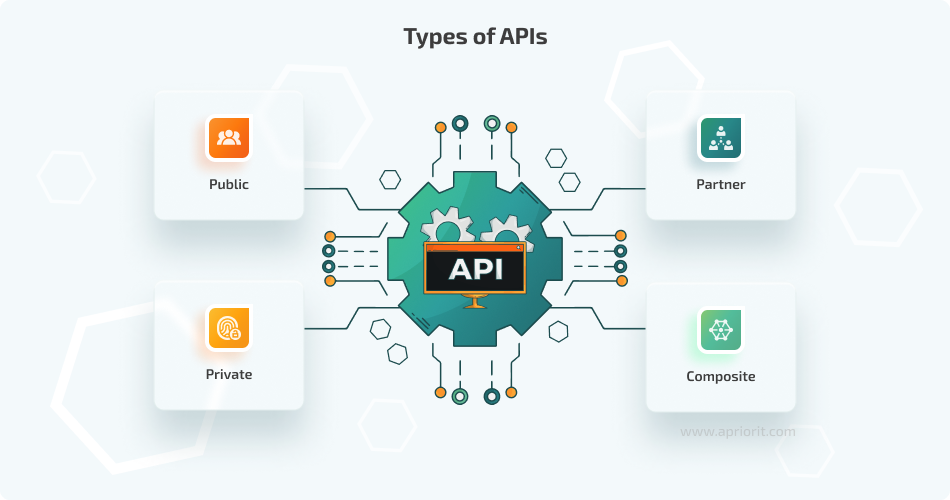
Public APIs. These openly accessible interfaces are available for any developer or business to use and are often monetized based on user volume or server calls. For example, Google Maps has a third-party API whose use is billed based on the number of searches. Public APIs facilitate data sharing between businesses and offer services such as payment gateways, mapping tools, and social media authentication.
Partner APIs. These interfaces are only available to partner companies and enable partners to interact. They are used to share semi-sensitive data, such as CRM records, and offer limited data access. To access another company’s data through this type of API, a partner must undergo stringent authentication procedures. Partners typically have strong security as well. Usually, partner APIs aren’t monetized directly, as businesses directly compensate partner companies for the services they provide, while APIs function as a secure conduit for providing these services. One of the most popular partner APIs is PayPal. Partner businesses can securely access and exchange data with the PayPal API to handle payments and verify financial information.
Internal APIs. These private interfaces operate within a company, connecting many software segments to create a unified business ecosystem. Although internal APIs are considered to have weaker security measures due to their internal use, there’s a growing awareness among companies regarding potential security threats. Governments also impose security requirements, such as the GDPR, CCPA, and HIPAA, prompting companies to enhance the security of internal APIs.
Composite APIs. These interfaces combine different APIs to manage interdependent operations or streamline complex processes without compromising performance or speed. Developers can tailor composite APIs to meet specific business needs, crafting unique experiences and optimizing workflows. This way, developers can reduce network overhead and enhance overall system performance.
In this article, we’ll talk about third-party APIs, which are usually either public or partner APIs. Let’s take a look at why you should be adding these application programming interfaces to your software and what to consider before doing so.
Seeking reliable API integration solutions?
Connect with us to discover how our expertise in API integration can elevate your application’s performance and functionality.
Benefits and challenges of third-party integrations
So, what is third party API integration? It offers business owners the advantage of a ready-made solution without the need to build their own software from scratch. However, before deciding to integrate an API into your software, you need to explore the possible advantages and pitfalls.
Here are the third-party integration benefits for your business:
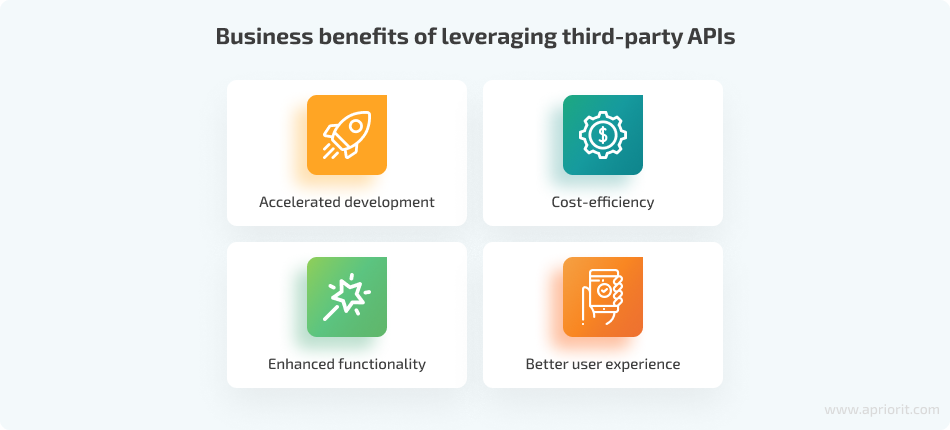
- Accelerated development. By integrating existing solutions, you can save lots of time that would otherwise be spent on developing something that’s already available.
- Cost-efficiency. APIs are relatively cheap and quick to integrate, so you can invest saved resources in developing unique features that will make your software stand out from the competition.
- Enhanced functionality. You can leverage access to well-tested functionality developed by companies with extensive experience in their domains.
- Better user experience. You can provide your users with a richer experience, including functionality such as secure payment gateways, social media login, or language translation services.
APIs greatly aid the software development process, but they come with certain concerns. Before adding third-party integrations to your project, here’s what you need to consider:
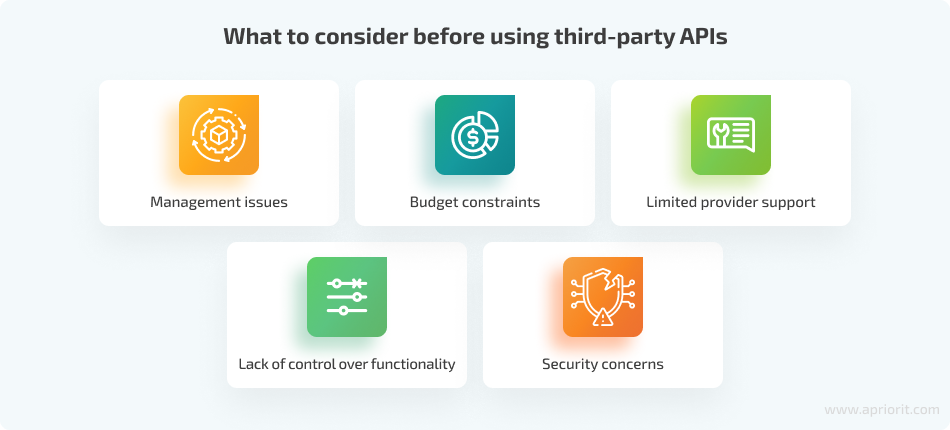
- Management issues. While adding functionality via APIs is convenient, too many third-party integrations can make your app’s infrastructure chaotic and hard to manage and maintain. Different API providers have different agreements and latency times, and these inconsistencies may cause performance issues and data reception problems during integration.
- Budget constraints. Fixing issues caused by integrating too many APIs may inflate project costs, even though third-party integrations are usually budget-friendly. Fixing any issues with your APIs, including security, functionality, or infrastructure issues, requires additional spending on your part.
- Limited provider support. If something stops working, you can’t always rely on your provider to quickly fix the issue. Dependence on API providers for issue resolution may result in production delays.
- Lack of control over functionality. Third-party API providers determine available functionalities, limiting customization options. So, you need to take it or leave it when it comes to their set of features. Don’t expect a third-party integration to suit all your personal needs and preferences: in most cases, you’ll need to adapt your project and seek compromises.
- Security concerns. Before integrating a third-party API, carefully assess the security measures implemented by the API provider. Make sure that your chosen API provides robust authentication methods to identify users and authorize access to endpoints. Otherwise, your sensitive data might be susceptible to various threats like man-in-the-middle attacks.
It’s worth noting that most popular API providers strive to accommodate developers’ and businesses’ needs, but smaller development companies may lack thorough testing. From our experience, we recommend you exercise caution with less-known APIs that might not have gone through a rigorous third party integration testing process. Now, let’s see how to make your APIs function effectively with the help of correct protocols.
Read also
API Management Essentials: Strategies and Tools
Explore how you can seamlessly manage and assess the performance of your APIs with the help of management tools and metrics.

How to choose the right API protocol for your third-party integration
For APIs to function seamlessly, they need to follow certain rules, constraints, and structures enforced through protocols and architectures. Modern APIs use three main protocols, or formats, each with unique characteristics suitable for specific purposes.

REST (Representational State Transfer) is the most widely used API protocol. REST employs a client–server approach that segregates the API’s front end from its back end. REST is stateless, meaning that APIs do not retain data between requests. RESTful APIs can communicate directly or via API gateways and load balancers.
SOAP (Simple Object Access Protocol) is an XML-based protocol that also supports HTTP, SMTP, TCP, and other protocols. In contrast to REST, SOAP follows a more structured and standardized approach, which includes a defined set of rules and specifications for message structure, message processing, error handling, and communication protocols.
RPC (Remote Procedural Call) is a simple way to send parameters and receive results. While REST APIs are used for data and resource exchange, RPC is more suitable for processes and actions. RPC is compatible with JSON and XML for coding, and APIs will be called JSON-RPC or XML-RPC based on the chosen programming language.
An API format defines the way your application works, so it’s important to choose wisely and consider your business needs. Here are several factors that can influence your choice of an API protocol:
- Complexity of data to be exchanged
- Target security level
- Speed and performance requirements
Let’s talk about REST and SOAP, for example. Both of these formats use HTTP protocols and similar commands. Both can use XML in requests and responses. However, SOAP relies solely on XML, while REST can also work with JSON, HTML, and plain text. This makes SOAP more restrictive than REST.
SOAP is used by enterprise software products, as it’s easier to manage complex data exchanges when the rules are limited and standardized. Thus, SOAP remains prevalent in internal and partner APIs. In contrast, the more flexible REST format is used for its simple data exchanges, scalability, and active user base. Most public APIs choose the REST protocol.
| REST | SOAP |
|---|---|
| Works with XML, JSON, HTTP, and plain text | Works with XML |
| Flexible, architecture-based rules | Strict, standardized rules |
| Medium security | High security |
| Suitable for data | Suitable for processes |
| Highly scalable | Limited scalability |
RPC shares some similarities with SOAP in terms of its structure and process-oriented functionality. It can work with both JSON and XML and supports different programming languages like Python, PHP, and Java, just like SOAP does. RPC excels in handling calls without waiting for responses and enabling asynchronous calls and quick responses, enhancing its suitability in these environments. These qualities make it suitable for internal composite APIs. However, RPC might not be the optimal choice for enterprise APIs due to its limited security and data type support.
Let’s now talk about how to work with third party API integration into your software in the best way possible and avoid the potential pitfalls of API integration.
Related project
Building a Microservices SaaS Solution for Property Management
See how outsourcing SaaS development to Apriorit helped our client get a new user-friendly design and a scalable microservices architecture.
Third-party integration: tips from Apriorit experts
Using the full potential of third-party APIs requires a strategic approach and attention to detail during the development process. Apriorit specialists have extensive expertise when it comes to API development and integration, so we have created our own set of third-party API integration best practices. These tips can help you achieve smooth integration, enhance application performance, and create a seamless user experience within your software ecosystem.
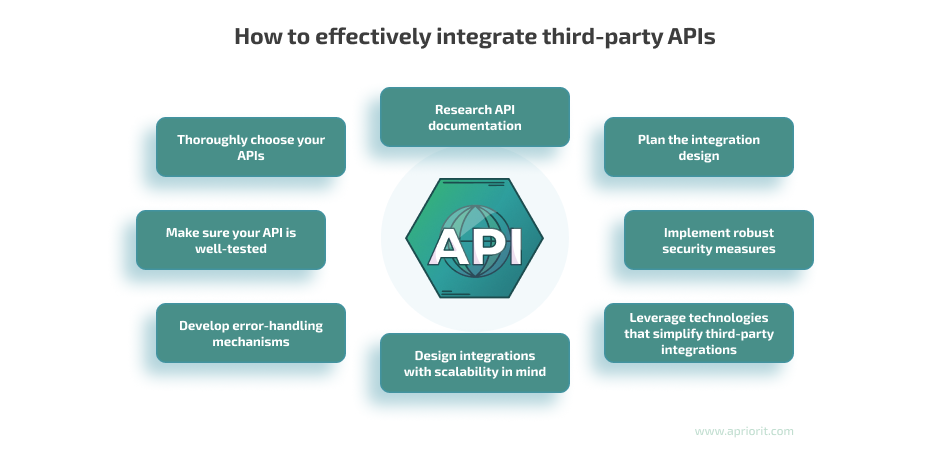
Thoroughly choose your APIs. Before integrating any third-party APIs, evaluate several options based on their functionality, security, documentation quality, performance history, reliability, and provider support. Choose APIs that align closely with your project’s requirements and long-term goals.
Research API documentation. When choosing an API, pay attention to its documentation, and choose a provider who provides extensive details about their API, integration instructions, and usage manuals. Clear, extensive, and up-to-date documentation is vital for understanding:
- API functionalities
- Endpoints
- Request and response formats
- Authentication methods
- Rate limits
- Error handling
- Integration procedures
Detailed documentation helps to streamline the integration process and simplify troubleshooting so there are no surprises for your development team or your business during and after integration.
Plan the integration design. Follow the API provider’s guidelines and best practices meticulously during integration. Comply with rate limits, authentication protocols, data formats, and any usage restrictions outlined by the provider to prevent service disruptions or account suspension. It’s always a good idea to push the integration process even further:
- Minimize the integration of unnecessary services: for example, by adding only those APIs that you need to keep your architecture simple and manageable.
- Prioritize modularity by designing your architecture with a clear separation of concerns to isolate potential integration issues.
- Standardize communication by using common protocols and data formats like JSON or XML for seamless interactions.
Make sure your API is well-tested. API errors may cause lots of issues, from functionality loss to significant downtime, where every second cost you money. Don’t simply trust that your provider has reliable QA procedures, but conduct your own testing. From our experience, it’s best to develop your own third-party integration testing strategy that covers API functionalities and integrations under various scenarios, including normal operation, edge cases, and error conditions. With the help of monitoring systems, you can track API performance, response times, error rates, and usage patterns. This will allow you to identify issues proactively instead of relying on your provider.
Implement robust security measures. APIs usually offer their own security measures, but they might not be enough to guarantee you peace of mind. Implement your own security measures as you integrate third-party APIs to safeguard your application, user data, and sensitive information. Here are some examples of security measures that can help you elevate your software’s security posture:
- Encryption and secure communication. Use encryption protocols such as SSL and TLS to secure data transmitted between your application and API endpoints. Also, always establish connections via HTTPS when communicating with APIs. HTTPS encrypts data in transit, preventing eavesdropping and tampering, thereby ensuring data integrity and confidentiality.
- Authentication and authorization. API keys, Open Authorization (OAuth), or tokens can help you validate and authorize requests, preventing unauthorized API access. Also, with the help of fine-grained access control, you can restrict user access privileges based on roles or permissions.
Make sure to regularly update your APIs to benefit from security enhancements, bug fixes, and patches that address known vulnerabilities. The same goes for any libraries, frameworks, and dependencies related to third-party APIs.
Read also
A Practical Example of Testing a Web API for a Cybersecurity Solution
Learn how you can boost your product’s efficiency through API testing without compromising security.
Develop error-handling mechanisms. These mechanisms will help you manage unexpected responses and disruptions from third-party APIs. Errors or disruptions from third-party APIs are inevitable, so it’s best for you to focus on these key practices:
- Use proper error codes and status messages
- Implement fallback procedures and graceful degradation
- Provide your users and administrators with informative feedback about errors
- Employ intelligent retry mechanisms and back-off strategies
By incorporating these practices, your software can better handle unforeseen disruptions and errors from third-party APIs, providing smoother user experiences and improved overall software reliability.
Design integrations with scalability in mind. You need to think about how your business will grow and expand in the future before you implement APIs. Implement modular, flexible architectures that allow for easy updates, scalability adjustments, and the addition of new functionality without extensive rework. Otherwise, you risk having to rewrite code and change the third-party integrations you made when your audience was smaller and your product had fewer features.
Leverage technologies that simplify third-party integrations. You can streamline the integration of third-party APIs with the help of different tools, languages, frameworks, and platforms, making the process more efficient and manageable. Among these tools, Python stands out as a versatile programming language with robust libraries and frameworks that can simplify API integrations. Here’s a list of Python-based tools you can use to simplify API integration:
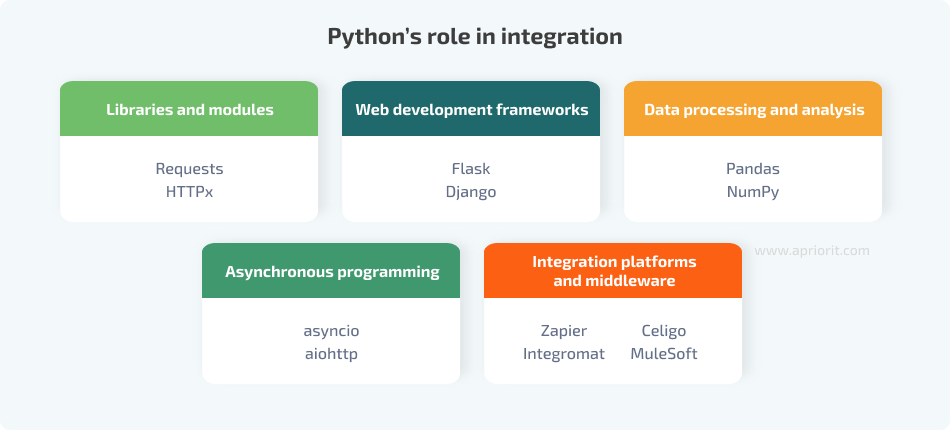
By leveraging Python’s versatility and the wide range of tools and frameworks it offers, your developers can streamline the integration process, efficiently manage API interactions, and effectively handle data within your applications.
Conclusion
Third-party integrations through APIs have become a convenient and fast way to add functionality to software. By strategically leveraging APIs, you can elevate your software beyond the limitations of in-house development, such as by adding secure payment gateways or translation services without needing to start from scratch.
At Apriorit, we specialize in providing top-tier API integration services. Our team of experienced professionals offers a comprehensive development approach to streamline your application’s integration processes with a focus on robust security, scalability, and efficiency.
Looking to enhance your software with third-party APIs?
Reach out so we can boost your software’s capabilities and user experience.


